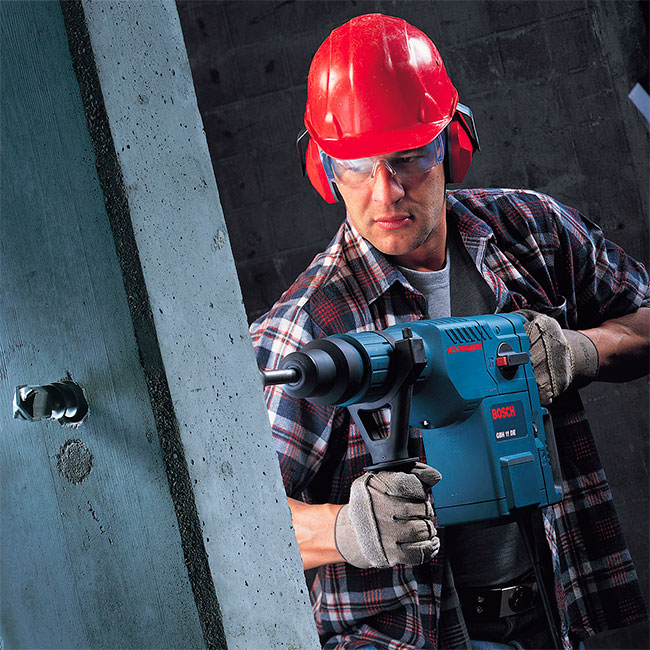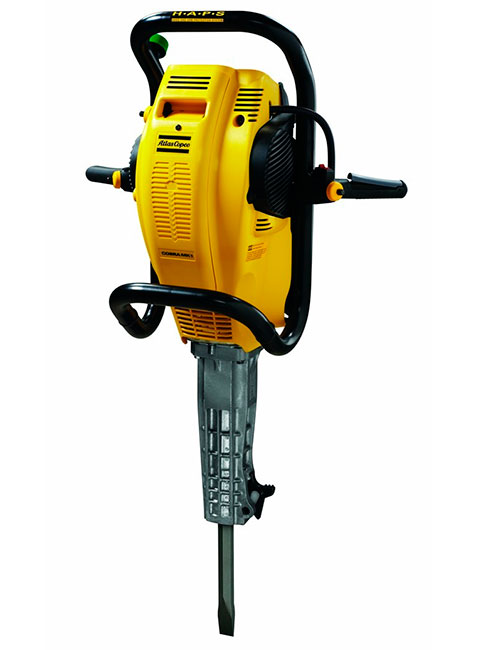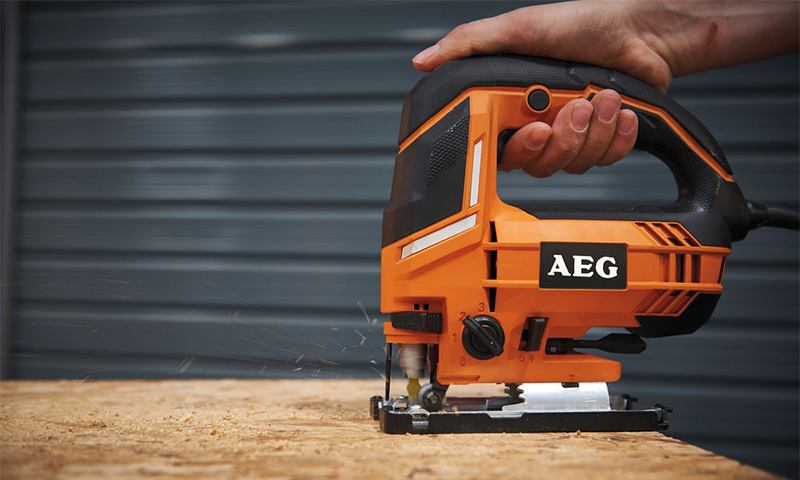When neighbors make repairs, the first thing that is heard most loudly is the work of a punch. But deciding to install a suspended ceiling in your home or to change the atmosphere of an ordinary apartment in a studio, you realize that this is the most indispensable tool. Thanks to the perforator, you can quickly make holes in brick, concrete and stone. With small nozzles it turns out to perform drilling and create attachment points. With large peaks it is possible to quickly disassemble the partitions and redo the layout both in the bathrooms and in all apartments.
Other models of perforators are used in road repairs or in industry. But this tool has many features that are important to know in order to properly perform the work and not to spoil the wall. Incorrect choice of the model can even create an emergency situation in certain conditions. Therefore, knowledge of key parameters and features will help to carry out a competent choice for any needs.

Content:
The best manufacturers of drills - which company to choose
European and Asian companies have been competing for a long time in the manufacture of high-quality construction tools.
If you understand all the possible differences and the parameters simply do not have time, and you need a quality punch for permanent work, then you can purchase a model from any of the following manufacturers:
1. Makita
2. Bosch
3. Dewolt
4. Bort
5. "Interskol"
But due to the large range of characteristics of this tool, it is advisable to get acquainted with specific models of these firms in ranking of best drills, to be sure of the suitability of the device for certain types of work. Those who wish to understand everything on their own, this article is devoted to a detailed review of the device and the criteria for its selection.
The principle of operation and the device punch

The perforator is fundamentally different from the hammer drill with its punching function. The key action of this tool is precisely a powerful blow to the wall, which does not depend on the force of the user's pressing. The drills are designed primarily for rotation, and the shock function is to lightly tap the drill with the mechanical part.
The main load in the drill is created only by the pressing force. Therefore, it is possible to work with a perforator even for people with little physical training, since in order to perform its tasks it is necessary to direct and hold it without additional actions.
Due to the powerful chiselling, the perforator is able to pierce holes both for the creation of subsequent fasteners and for the destruction of part of the wall for various needs:
- creation of ventilation units;
- making openings under the doors and windows;
- disassembly of partitions for access to pipes;
- shtabeniye of a wall under conducting and communications.
To perform such actions, the punch has special internal elements. In most models there is an electric motor to which voltage is transmitted through brushes. The current causes the armature to rotate and transfer torque to a “drunk” bearing.
The latter got its name due to the movable part during torsion. The drill is inserted into the cartridge with a bit or peak, and the electric motor starts the rotation. The bearing catches the piston, which accelerates and hits the ram. The force is transmitted to the firing pin, which leads to rapid penetration of the holes.
In addition to the key assembly in the punch there is a cartridge for fixing the drill or pick and the main handle with a start button.Most models are provided with a trigger lock, so as not to waste efforts on its retention during long work. The second handle helps to take and more accurately guide the tool. To change the modes provided variolok. The switch establishes the method of influence on the surface: rotation, impact and rotation, or only impact.
To determine the depth of breakdown on most models there is a plastic ruler attached to the body, resting on the wall, it shows how much the drill has penetrated into dense material.
In the event of a drill jamming in the wall, a coupling is provided that separates the nozzle and the rotation mechanism. This helps to avoid knocking the tool out of the hands and preserves the integrity of the internal components. To continue, the reverse is started and the drill is removed.
Types of perforators
Despite the common purpose, perforators have several types, which determines their functionality and area of use. Understanding these differences will narrow the tool selection area.
Network drills

Due to the constant connection to the power source, these models have great power and high performance. They are widely used in repair work and electrified construction sites. With their help, it is easy to make walls and make openings in partitions.
Advantages:
- have three modes of operation;
- affordable cost;
- equipped with additional functions (depth stop, comfortable handles, trigger locks);
- high performance;
- adjustable rotation speed;
- housing design with anti-vibration inserts;
- practical cases for easy transportation.
Disadvantages:
- movement is limited by the length of the cord;
- with frequent use, the force of fixation of the drill weakens, and the cartridge has to be changed;
- performance decreases with a general voltage drop.
Cordless drills

This type of tool belongs to the household and is designed for short use in places where there is no electricity. With the help of the battery punch it is possible to make several holes in the wall for reliable fastening of the suspended structure or to create an opening for ventilation. But for long work, it is not suitable.
Advantages:
- due to independence from electricity there are no restrictions on the place of use (garage, cottage in the woods, summer cottage);
- high power for stand-alone device;
- the presence of reverse;
- a light weight;
- drilling concrete with a hole diameter of 10 mm;
- compact body;
- convenient transportation;
- speed control.
Disadvantages:
- the duration of the work is limited by the battery capacity;
- a fall from a height is fraught with battery failure;
- not suitable for frequent use;
- It is difficult to buy a battery separately.
Pneumatic drills

This tool has an electric motor in its device, which is driven by a stream of compressed air from the compressor. Further, the process continues as in the network models, but the impact force is formed by the pneumatic supply of the piston by pressure. These drills are used in enterprises where there is a centralized air network (pipes with compressed air) to save electricity, or in specific conditions where sparks from voltage can lead to an explosion (mine).
Advantages:
- a large number of beats per minute;
- drilling of brick, concrete, metal;
- soft hose can be long and does not limit movement;
- two modes of operation;
- lightweight apparatus;
- the presence of depth adjustment;
- auxiliary handle;
- easy to disconnect from the hose;
- simple transportation;
- high rotational speed.
Disadvantages:
- to start working, you must wait for the accumulation of pressure in the compressor tank;
- high price;
- can only be used where there is an air network or compressor.
Petrol drills

This category of tool is used in the initial stages of construction and renovations, when great destructive power is needed (removal of walls, old foundations).The devices are completely independent of current and air, and are able to operate throughout the day. Differ in high impact force. The second area of application is road repair.
Advantages:
- the ability to work from one refueling about two hours;
- the presence of three modes;
- a blow of great strength;
- no wires interfering with the movement;
- The tool can work in any terrain (without electricity, remote structure).
Disadvantages:
- high price;
- larger sizes;
- additional costs for gasoline;
- bounce can lead to unnecessary cracks;
- the need to take a fuel can;
- big weight;
- no impact force adjustment.
Punch selection options

In order to choose the optimal device and not overpay for excessive power, but also not to break the apparatus after 6 months from excessive loads, it is important to know the key parameters of the punch selection. Here are the most basic.
Impact force
This criterion is responsible for the force with which the drill or peak will sink into the material, and is measured in joules (joules). The impact force is one of the three component productivity tools. Since it is not the worker’s pressure on the handle that plays an important role here, but the device’s indicator, for professional repair activities, where a lot of holes in the brick and stone have to be made during the day, it is necessary to purchase models with 4-12 J.
If only periodic use for personal needs is planned (to make an opening, to create attachment points under the dowels), then 1-2 J will be enough. During frequent work with a thick layer of concrete, models with 27 J. will be useful.
Impact frequency
The second component of performance is expressed in the frequency of shocks that the piston makes against the firing pin. Even with a large force of pushes, but a small number of beats, the work will be slow, so the frequency indicator is very important for professional activity, regardless of the hardness of the wall material. To fully work on repairs and construction it is worth buying models with parameters of 5000-6000 beats per minute. For home use the device with the number of 3000-4000 beats / min.
Power and shaft speed
The third component of performance is the speed of rotation of the cartridge. Although the first two parameters described above are responsible for the depth of drilling, the rotation of the drill assists in the selection and removal of the crumbled material and the speed of drilling of thick elements. That the puncher could quickly make turns, the powerful electric motor is necessary. To drill thick walls you need to buy a tool with indicators of 700-1200 W and a speed of 2300-2500 rpm. If the task is to drill fasteners no deeper than 40 mm, then 400-500 W and 1000-1200 rpm are sufficient.
But here it is worth considering the diameter of the drill. If you plan to work with small drills 5-8 mm in diameter, then you can use high rotation speeds (1500-2500 rpm). When drilling wide holes, a thick drill at fast speed will wear out and it will have to be changed more often, so small turns (600-1000 rpm) will be needed here.
Type of mounting chuck and drill diameter
This parameter is denoted by several letters and can say nothing to an inexperienced buyer. But, without understanding, it is difficult to get the right product.
There are three categories of cartridges:
1. SDS +
It refers to amateur versions, which are universally suitable for most drilling and fixing points. They are able to clamp the drill with a diameter of up to 25 mm in concrete or 30 mm in wood. Such a puncher is good to have in the country or in the garage.
2. SDS max
It represents a professional niche of cartridges that fix large-sized drills and pierce holes up to 52 mm. This is convenient for quick creation of openings and wide shtenning. They are suitable for builders and full-time repair crews.
3. SDS top
This is the narrower direction of the drill chucks in the range of 16 to 25 mm. If holes of just such a diameter are needed and others are not foreseen, then we can confidently acquire such an option.It is best to use them for drilling attachment points of suspended ceilings.
Having bought a hammer drill with a certain chuck, it may turn out that a large-diameter drill bit does not enter into it or small borax slip out. Therefore, it is worthwhile to think over most of the work with the tool and decide on the optimal type of clamping device.
Number of modes
Single-mode drills do not happen, otherwise it would be a regular drill. Dual-mode models can work on rotation and rotation with a blow. Oscillatory movements contribute to the penetration of the drill and the rapid passage of material through. The third mode allows you to stop the rotation and work only longitudinal impact function.
The more modes, the more expensive the tool, so three-mode models should be purchased for various activities (drilling, creating holes for fasteners, through-drilling, chipping for pipes and wiring). If a perforator is needed to drill into a concrete wall, then a dual-mode design is sufficient.
Weight and shape
The perforator has to work in different spatial positions, so the weight and shape of the device directly affect comfort and fatigue. Models with a horizontal engine are lighter (2-3 kg), which makes them optimal for ceiling work or manipulation on outstretched arms.
Devices with a vertical engine are heavier (4-6 kg), but more compact and balanced for holding with two hands and drilling walls. T-shaped models are most suitable for work in the lower position (drilling of the floor, asphalt) and have the heaviest weight (7-9 kg).
Power source capacity in the case of standalone versions
When choosing offline models on batteries, the capacity of the battery plays a big role. This parameter determines the time of using the device without a network. For rare use, 1.5-2 A / h is enough to drill a few dozen holes. If volume work is needed without the possibility of recharging, then it is worth buying a model of 3-4 A / h.
In the case of the petrol version, the capacity of the fuel tank is responsible for the autonomy. A volume of 0.9 liters is enough for two hours of work without interruptions. But if you take a can of gasoline with you, then the capacity of the barrel stops playing a big role.
Extra options
In perforators there are small additional elements that facilitate the use of the tool:
- If the exact depth of drilling is crucial, then a model with a limiter is useful;
- With the priority of work only by a blow, holding the perforator will facilitate the antivibration system;
- Soft start will relieve from overheating and prolong the life of the device;
- The reverse will allow you to quickly remove the jammed drill at great depths;
- Adjusting the rotational speed will give greater freedom in the diameters of the drills used.
Which punch to choose

In view of the above parameters, it is possible to classify all perforators into groups for a specific activity:
1. For professional builders and repair crews with a full-time job, a network puncher with a blow force of 6-10 J, a power of 1000 W and 2500 rpm will be suitable. The cartridge is worth looking for SDS max. The device should have three modes of operation.
2. In the case of an auxiliary network tool for a home craftsman, a strike force of 2-3 J and a power of 500 W are sufficient. The number of revolutions will depend on the type of drills used: 1500-2000 r / min for fasteners, and 600-800 r / min for thick drilling. Chuck in most cases SDS +. The number of modes depends on the needs of the owner: drilling concrete walls will require a dual-mode tool, and shaving will be effective on a three-mode model.
3. When it is necessary to work in the field, a battery punch with a capacity of 4 A / h and an SDS + chuck will come in handy.For large-scale work it is better to buy a gasoline unit with a vertical engine.
4. If there is an air line nearby, then a pneumatic perforator will help to save money. It is especially important to use it in a mine or other gas-contaminated space with a high explosion hazard. The cartridge and impact force should be chosen based on the employment of the tool, as in the above cases.
How much does a punch

Summing up the various groups of the tool, you can allocate its approximate value for specific tasks:
1. Professional powerful network models with high impact force and high frequency will cost 25,000-27,000 rubles.
2. For home use, the cost range of electric perforators is 1800-5000 rubles.
3. Battery versions cost 3500-4500 rubles.
4. Due to high power, petrol models cost from 25,000 to 65,000 rubles.
5. Pneumatic equipment will cost 47 000 - 94 000 rubles, depending on the shape of the body and the force of impact.
It will be interesting to friends too






